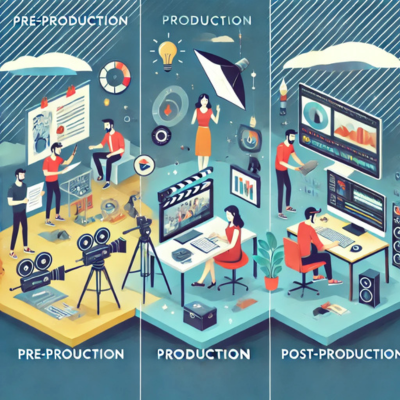From Script to Screen: The Ultimate Guide to Video Production
From Script to Screen: The Ultimate Guide to Video Production takes you through every part of the video making process, from initial concept to finished product. Be a budding filmmaker or a veteran content creator, it surely helps to understand the entire video production procedure for realizing one’s vision. This guide will take you through every stage, starting from scriptwriting to all the tricks on keeping your work from the camera’s eye to processing and polishing in post-production. With the right knowledge and approach, your videos will capture your audiences.

1. Understanding the Video Production Process
Video production is a multi-stage process that involves the translation of ideas to a compelling audiovisual narrative:
Pre-Production: This stage deals with brainstorming, script-writing, storyboarding, location scouting, and team assembling with proper planning, channeling a smooth workflow during filming.
Production: This is where actual filming happens under the supervision of directors and cinematographers, together with the crew, to capture quality footage. Lighting, camera angles, and sound are really important in this stage.
Post-Production: This is where the footage is edited, color-corrected, sound-designed, and given the special effects needed for putting together a finished video that has a level of professionalism while being entertaining.

2. Crafting a Compelling Script
The strong script, of course, is the backbone of a successful video production, which works like a blueprint guiding story, dialogue, and visuals. Here is how to go about writing a strong script:
The Concept – Begin with an idea: draw the outline of your video. Who are your audiences? What do you want to tell them?
Structuring Your Story – Have a proper beginning, middle, and end: Strong opening to hook viewers, build up tension or interest in the middle, and satisfying ending.
Writing the Dialogue – Keep dialogues real, short, and to the point. Use only the necessary jargon. Ensure that the script flows naturally.
Visual and Audio Directions – Indicate which camera angles will be used, what sounds will be heard in the background, and what visuals need to be on screen as layers of storytelling.
Revise and Polish – A good script depends on multiple drafts. Ken edit these ideas for clarity, pacing, and engagement?
Here the ultimate guide to video production.

Example:
Movements of the camera serve a critical dimension to the emotional impact of a scene. For example, a steady tracking shot emulates the character’s journey and can make audiences participant on the action or make them feel like part-and-parcel of a character’s experience. Sudden and erratic moves, for instance, whip pans or shaky handheld shots, methodically show the internal states of characters or provide high conflict for that particular scene. Smooth and flowing movements create scenes of calmness and fluidity. Whereas abrupt movements bring an element of surprise or disorientation.
3. Pre-Production Planning: Setting the Stage for Success
Well, pre-production is the cement of a successful video production. This phase is all about putting together all pre-production gears and elements so that production may smoothly flow into execution. Here are the steps to be taken:
Concept Development & Script Finalization – Set the objectives of the video, its audience, and its message. Finalize the script and make necessary revisions.
Storyboarding & Preparing Shot Lists – Do storyboards for every scene and prepare thorough shot lists to facilitate the production phase.
Location Scouting & Set Design – This is where you gather your choice of best locations according to your script and move into set designs that work for the visuals.
Casting & Crew Assembly – Actors are selected as crews with key people such as directors, cinematographers, and sound engineers.
Scheduling & Budgeting – Go for scheduling; allocate resources; keep updating them with the budget.
Good pre-production planning reduces last-minute complications and strives to keep production on track and organized.
4. Lights, Camera, Action: The Art of Filming
The production phase is when the vision for your video actually gets built. In this phase, the cameras roll and the actors perform while the director keeps everything in sync with the schedule. These are the main things to keep in mind for a successful shoot:
Lighting Setup – The right light sets the mood and makes the video look good. For an outdoor shoot, rely on something like sunlight, and for studio work, make full use of studio lighting.
Camera Angles & Composition – Use unconventional angles while framing your shot by trying different approaches and movements to create dynamic-looking shots.
Audio & Sound Quality – High-quality sound is as vital as good video. Use external microphones to prevent any background noise.
Directing & Acting – The director brings the actors and crew to their feet for the purpose of mounting the script. Thus ensuring that emotion and action match the story.
Shooting Principles – Follow the shot list to make sure you keep the continuity of events and take many variations during each shot to give you more options during the edit.
5. Post-Production Magic: Editing and Effects
In fact, the ultimate guide of video production is the last part of the filmmaking process is where all the raw footage forms into a final product that is actually smooth and engaging. This is where editing takes place-including color correction, sound designing, and visual effects to modify the overall sensation of the video.
Here’s how it goes: Video Editing-the cutting-up of clips and then arranging them into a smooth flow and pacing of the story. Refining several sequences and adding transitions to achieve a professional touch.
Color Correction and Grading-This involves brightness, contrast, and color adjustments for a neat and cohesive look.
Sound Design and Music-Enhances audio quality, removes unwanted noises, puts in some sound effects, and selects the right scores for setting moods.
Visual Effects (VFX) and Graphics-adding motion graphics, animations, and special effect to make videos more captivating and visually dynamic.
Final Review & Exporting-the proof for the whole video for errors, proper formatting, and exporting in high-quality resolutions for different platforms.
6. From Script to Screen: Bringing Your Vision to Life
- Scriptwriting: The story is written as a script, outlining dialogue, actions, and settings.
- Pre-Production: Planning phase, including storyboarding, casting, location scouting, and set design.
- Production: Filming the script, involving acting, directing, cinematography, and on-set decision-making.
- Post-Production: Editing the footage, adding sound effects, music, visual effects, and color grading.
- Distribution & Marketing: Finalizing the film and promoting it through trailers, posters, and distribution to audiences.
Each step works together to bring the script’s vision to the screen.
Conclusion
While a strong concept with a well-prepared script might begin the foray into video production, the real burden is borne in pre-production planning, by starting to work in editing, sound design, and visual effects to bring everything into the refined product through skillful filming techniques and creative direction. It brings together these stages seamlessly to create a vision-the transforming of an idea into actual video production-from script to screen, resulting in nothing less than a professional video project.
For more blogs like this click here.

